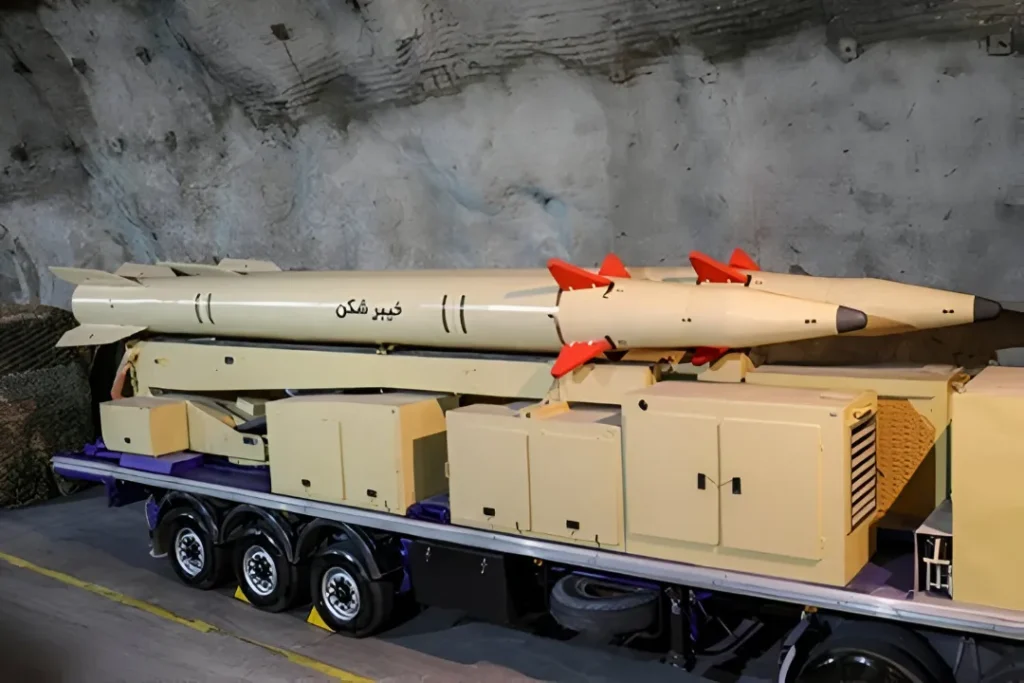Iran Deploys Kheibar Shekan Missile, Hints at Further Escalation
On Sunday, Iran’s Islamic Revolutionary Guard Corps (IRGC) confirmed the deployment of the Kheibar Shekan, its latest medium-range solid-fuel ballistic missile. This move indicates that Iran has not yet utilized its full range of military capabilities in its recent attacks on Israel, suggesting the potential for further escalation.
Specifications and Capabilities of the Kheibar Shekan
Unveiled in 2022, the Kheibar Shekan is a third-generation ballistic missile measuring 11.4 meters in length with a striking range of 1,450 kilometers. The missile is considered a significant advancement in Iran’s missile development program, largely due to its satellite-guided navigation and maneuverable warheads, which enhance its targeting precision.
Its compact design allows it to be launched from various platforms, including mobile and commercial vehicles, which makes it difficult to detect or neutralize before launch. The warhead itself weighs approximately 550 kilograms and can reach speeds of Mach 2 to 3 upon impact. These characteristics make the Kheibar Shekan a formidable challenge even for sophisticated defense systems like the Patriot and David’s Sling.
Origin and Operational Use
The missile was developed by the IRGC Aerospace Division and officially introduced by General Mohammad Bagheri, the former Chief of Staff of the Iranian Armed Forces, who was recently killed in an Israeli airstrike. According to reports, the Kheibar Shekan was first used during the “Sadiq Promise 1” and “Sadiq Promise 2” missile operations in April and October 2024. These offensives followed the assassinations of Hezbollah’s Hassan Nasrallah and IRGC commander Abbas Nilforoushan and involved the launch of around 180 missiles targeting Israel.
Kheibar vs. Kheibar Shekan: Understanding the Difference
Though often associated with the broader Kheibar missile family, the Kheibar Shekan is a distinct system with its own unique specifications. The original Kheibar missile, known as Khorramshahr-1, was introduced in 2017 and was significantly larger, at 13 meters long and 1.5 meters wide. The Khorramshahr-2 followed in 2019, featuring guided warheads and a total weight of 20 tonnes.
By 2023, Iran had unveiled the Khorramshahr-4, while details about the third generation (Khorramshahr-3) remain undisclosed, although sources confirm its existence. Unlike the Kheibar Shekan, the Kheibar missiles are designed for longer ranges and feature a maximum speed exceeding Mach 8. The absence of external control surfaces like ailerons further enhances their aerodynamic efficiency and makes them harder to intercept.
Symbolic Significance of the Kheibar Shekan Name
The name Kheibar Shekan, translating to “Breaker of Khaybar,” references the historical Battle of Khaybar in 628 CE, where early Muslim forces defeated a Jewish stronghold in present-day Saudi Arabia. In Shia Islam, the battle is particularly significant due to the prominent role of Imam Ali, regarded as the rightful successor to the Prophet Muhammad.
This historical naming not only reflects religious symbolism but also serves as a political message. For Tehran, linking the modern missile to a centuries-old battle frames the ongoing conflict with Israel in ideological and historical terms. The underlying implication is a continuation of that legacy, suggesting a broader objective tied to the eradication of the Israeli state.
The earlier Kheibar missile, also known as the Khorramshahr, derives its name from the Iranian city of Khorramshahr, which was a major battleground during the Iran-Iraq War in 1982.
Conclusion
The Kheibar Shekan represents a notable leap in Iran’s missile capabilities, combining technical sophistication with symbolic messaging. Its deployment not only showcases Iran’s strategic reach but also underscores the country’s intent to escalate regional tensions if necessary. With its versatility, stealth, and speed, the missile is a key asset in Iran’s evolving military doctrine.



















